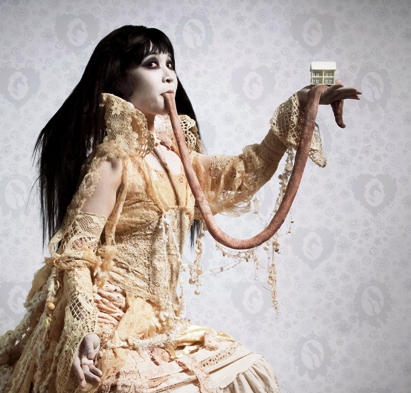We in the audience launched Degenerate Art Ensemble’s new show, as black-clad musicians Joshua Kohl and Jeffrey Huston conducted us from the aisles of the Moore Theatre in a chorus of mouth sounds (I sat in the t-k-t-k-t-k section), gesturing broadly to raise and lower our volume and making us sound like waves of choreographed locusts. This melded into similar whooshing sounds coming from a recorded soundscape, which ran more or less throughout the two-hour show over stage-front speakers, while Kohl and Huston’s arm sweeps were echoed—now empty and yearning rather than purposeful—by blue-skirted Trinidad Martinez. Kohl, now at his electric guitar atop a scaffold at stage rear, continued the mouth sounds as Martinez danced and vocalized.
After its two-night run on Halloween weekend, it remains to be seen when and if DAE will be able to restage their elaborately interwoven Sonic Tales. The group’s method of artistic construction, seemingly, was to use every idea they had. Their strategy to keep it from being merely a parade of strung-together ideas was to use them all twice.
Panels with doors soon slid onto the stage, and from one of them popped Marissa Rae Niederhauser as a blonde, kimonoed sprite. Metal bowls and pots descended on a pipe; an ominous voice from the speakers warned Martinez away from them, so she played them by manipulating Kohl from behind, like a puppet. This gently chaotic clanking ushered in Haruko Nishimura, in an elaborate costume dripping with tattered white lace. She undulated spasmodically, her mouth open unnaturally wide as if something horrific were going to crawl out of it, her hand scrabbling on the floor like some separate creature. Later, she climbed the scaffold to join in a song; her voice, Ono-like, ranged from breathy girlishness to guttural noises.About where the intermissionless show’s second half would begin, Martinez again pressed the audience into service, leading us in imitating rain and wind as video images of a lightning storm were projected onto the set.
In another vignette, Nishimura, dressed in red, stood behind a counter of kitchen supplies, as if hosting some nightmarish cooking show; she sang along with a video of herself, punctuating the song with knife thrusts. When she emerged from behind the counter, we could see her dress was built over some sort of hoopskirt armature which she can stand on from the inside to spin like a top—the “Weeble Wobble Dress,” designed and built by Colin Ernst. Metal resonating tubes attached to its sides were played, adding clear, bell-like tones to the pots and pans again wielded by Kohl and Huston, now practically a full orchestra of percussion.
Sonic Tales is the fullest realization yet of the syncretic vision hatched 15 years ago at Cornish College by composer Kohl and dancer Nishimura. Unique among local theater troupes, DAE doesn’t recognize the usual divisions of labor between music and dance—cast members contribute both aurally and visually nearly every moment they’re onstage—or costume and sculpture. Credited to five designers led by Christine Tschirgi, the costumes’ Matthew Barney–ish, alien-life-form extravagance climaxed as Niederhauser, the “Slug Princess,” oozed onstage in a huge, puffy, tangly, raggedy, yarny yellow thing (then grasping a thread to rather erotically unravel it) and Nishimura returned in an even more monstrous lace creation.
Still, too much synthesis can be just too much. Combining so many mirrorings, recyclings, self-references, and doppelgängers is a good way of rewarding audience members who pay attention and enjoy participating in the spectacle. But it also means the show could stand tightening by a good half-hour.







